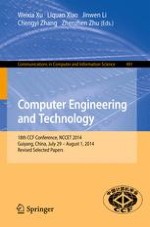2015 | Buch
Computer Engineering and Technology
18th CCF Conference, NCCET 2014, Guiyang, China, July 29 – August 1, 2014, Revised Selected Papers
herausgegeben von: Weixia Xu, Liquan Xiao, Jinwen Li, Chengyi Zhang, Zhenzhen Zhu
Verlag: Springer Berlin Heidelberg
Buchreihe : Communications in Computer and Information Science
